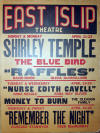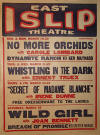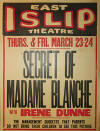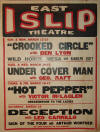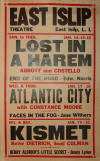Main Street
|
|
|
|
|
|
|
|
|
|
|
|
|
|
|
East Islip's First Postmaster - George Hanford
George Hanford and his wife Sophia were born in England. George born in 1825, was a farmer. It is not known when they came to the United States. In September 1854, George Hanford bought five acres of land from William Nicoll on the north side of Main Street in East Islip. The property ran easterly from what is now the westerly line of Third Avenue about 218 feet and northerly from Main Street to 100 feet north of what is the north line of Court Street. He later acquired additional property to the East bringing his property 90 feet west of what is now the westerly line of First Avenue.
The above property was divided into lots. Third Avenue, Second Avenue and Court Street were built. The property was then divided and conveyed to his family sons: Albert, John, Maitland and Grandson Freeman. George built his house on the original purchase on the northeast comer of Main Street and Third Avenue, which has been torn down in recent years and replaced by a modem building. Maitland Hanford constructed a building east of George's homestead and operated a sporting goods store and a bicycle shop there in 1908.
The bicycle shop became a place where some of the East Islip and Great River men gathered after supper. This was where the East Islip Club, a social club, came into being. Most of the men of East Islip and Great River became members.
Shortly after the original land was divided, Maitland and John Hanford purchased an adjoining parcel of land to the East and established First Avenue with lots on either side. The total Hanford property ran from the west line of Third Avenue to 90 feet east of First Avenue Albert Hanford had his house built on the easterly part of the original subdivide, and it is still there, formerly owned by Mr. Vincent Fortunato.
The last known descendant of George Hanford living in East Islip on the original Hanford property is Marianne Cote’, great granddaughter of George. The East Islip Post Office was established January 16, 1890. George Hanford was the first Postmaster. His son Albert became the 6th Postmaster February 2, 1911.
Popular Postal from the era showing the Post Office and St. Mary’s Steeple in the background.
East Islip Theatre
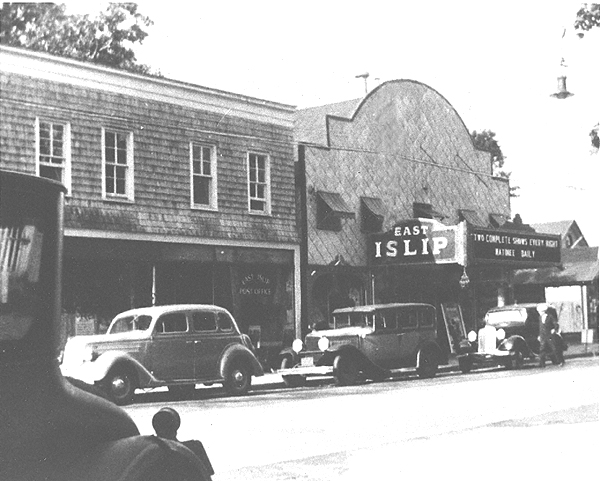
This is a Newsday
article written by Jim Poro's daughter:
"My father, Jim Poro, came to this country from Italy before the turn of the
century. He got his start in New York's vaudeville scene as a singing usher who
performed during intermission. That job led to one as a "song slugger" for music
publishers, which meant that he raced from composers to publishing houses,
singing songs the composers were hoping to sell. One of the songs he "slugged"
was the hit "Waiting for the Robert E. Lee," by L. Wolfe Gilbert and Lewis F.
Muir. Performance ran in the Poro family -- his brother was a dancer with the
Six Imperial Dancers and lived in Hempstead.
About 1910, my father became interested in the new motion picture industry and
started managing movie theaters in Astoria. In one of those theaters, he
befriended John Horn, the house nickelodeon player. One night, while eating
dinner at John's house, my father met his friend's sister, Katie. The two fell
in love and were married.
In 1935, after managing a theater in Northport for a short while, my parents
moved to East Islip, and the Poro family has been here ever since. My father
opened the East Islip Theater, which became an area landmark. The theater was
very romantic, and people used to walk there on dates before heading off to the
sweet shops for a soda.
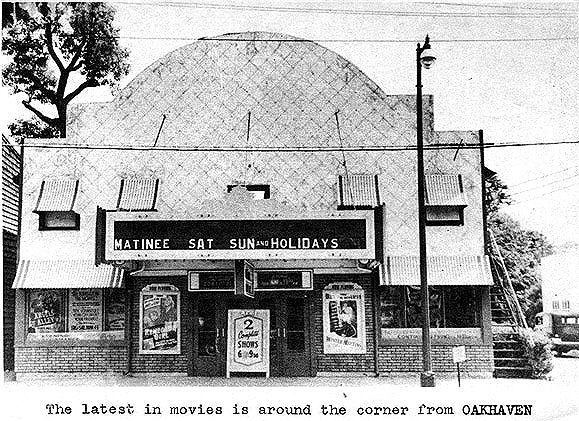
When I was a teenager in the 1950s, movies at my father's theater cost 20 cents,
the candy was a nickel and popcorn was 10 cents. He always let the priests and
nuns from St. Mary's Catholic Church into the Saturday matinees for free.
My father sold his theater in 1978, when he was 88. He died at age 99 in 1989.
In the early '80s, the building burned down.
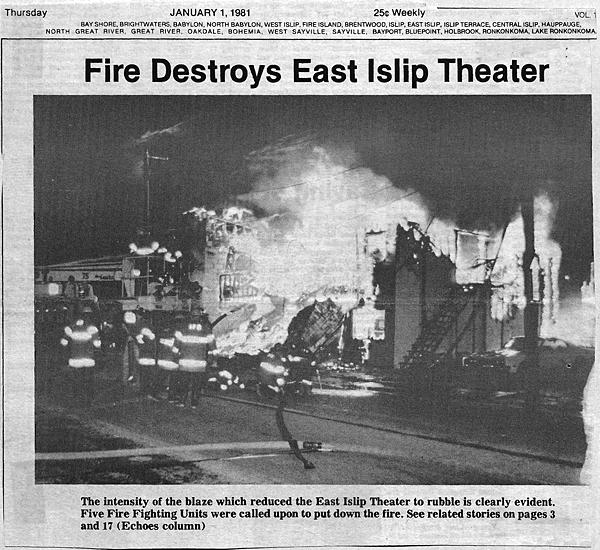
In 1980, he was honored as the oldest living member of the Motion Picture Pioneers, a national organization. Because he refused to sell his theater to the large syndicates, James Poro was widely respected in the theater industry".
Below are some Movie posters from the East Islip Theatre
Here is a reminiscence by a former projectionist from the East Islip Theatre
I was projectionist at the East Islip
from 1971-1973. I remember both Mr Poro the elder, and his son who's name I
think was also Jim, and who helped run the place. I remember once when I
inquired about the age of the building he told me that it had originally been
some sort of military warehouse during WWI. The elder Mr.
Poro also had a thick photo album of pictures taken of the theatre over the
years that he showed me once. I remember one photo in particular taken during a
WWII scrap rubber drive. You got into the movies free that day if you brought
some old rubber-goods you no longer needed. The photo showed a line of people
with old automobile & tractor tires, rubber hoses,
etc. stretching for at least a block down main street.
It was located next to a
Church. Mr. Poro would let the priests and nuns in for
free and they'd sit alone up in the balcony by themselves when they came to
watch a movie.
Up in the booth, they still had one of the original Western Electric ERPI sound systems. It still worked, but was used only as a back up to the main 1940 vintage RCA sound system. The projectors were ancient silent film vintage "Simplex Standard's" that had been converted to sound by adding a sound head. They still had the hand cranks for the projectors in the parts cabinet in the booth! I'd heard that they had an old Vitaphone machine in the basement. I inquired about it and Mr Poro said he'd show it to me. But the room it was in was locked, nobody had been in it for at least 20 years and he couldn't find the key. While going through old keys trying to open that door, we were able to get into an adjoining room that was filled a lot of old theatre-junk, including several cans of nitrate film that had decayed to a big glob of goop. I was able to see the vitaphone machine by shining a flashlight through a hole in the wall into the locked room we couldn't open.
When the theatre burned
down Christmas Eve 1980, I rushed to it first thing the next morning to see if
the old machines could somehow have been salvaged, or maybe I could at least
salvage one of the projector hand-cranks as a
souvenir! But the entire theatre had completely burned out and collapsed. It was
a cold morning and not only had the place burned down but now the ruins were a
solid block of ice from all the water poured on it during the fire. Somewhere
around here I have pictures of it.
JimC/SanFrancisco
Here is a Newsday Article on Jim Poro Wednesday, April 10 1985

















